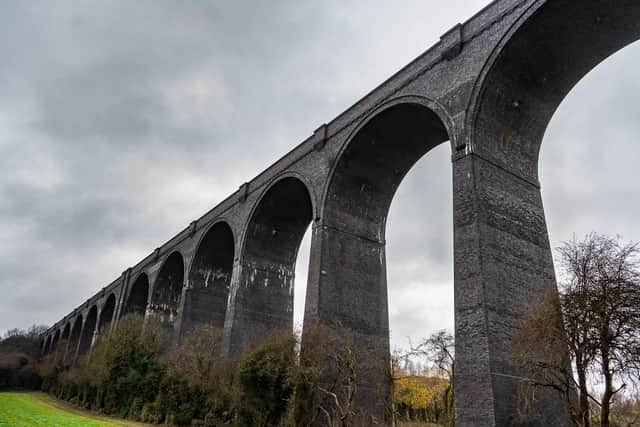Why Conisbrough near Doncaster offers much more than just the castle immortalised by Sir Walter Scott


You might have thought that Sir Walter Scott would have been flattered when a composer as distinguished as Gioachino Rossini picked up the manuscript of his best-selling novel Ivanhoe and turned it into a choral work. However, Scott went to one performance and was unimpressed, noting: “It was an opera and, of course, the story sadly mangled and the dialogue, in part, nonsense”.
Scott had published Ivanhoe in 1819, and it was an immediate success. He invented a yarn full of colourful characters and set the fanciful action in the years of the reign of Richard I. It was based in and around South Yorkshire, and the centre of the plot, with chivalry, jousting and a tortured love affair (not to mention a witch trial and some barely-disguised anti-Semitism), is the Castle of Coningsburgh. Scott changed his spelling very slightly, but the location is the same, and the three volumes of his book stirred up a vivid and sustained interest in Richard, his successor, the wicked King John, and, of course, Robin Hood, who appears as Locksley in the novel.
Advertisement
Hide AdAdvertisement
Hide AdSir Walter never saw the real-life ruins of Conisbrough Castle, but he must have done his research remarkably well, for the description of the great tower is accurate almost to the last stone.


In fact, the land around the town had been a royal manor, held by the last Anglo-Saxon ruler of England, Harold II, and the lands in those days stretched much further north, to Hatfield Chase, which was a popular hunting ground. Well over two dozen local townships gave allegiance to the Lord of Conisbrough, so it is hardly any surprise that, when William defeated Harold, he gave this corner of Yorkshire to a court favourite, William de Warenne, who immediately started building castles and forts. Historians believe that the hill on which the castle was built had been not only a fortified Saxon stronghold, but also a place given over to the local government of the day, a “Wapentake”. And the name of the community is also firmly rooted in Old English, the spelling of those times naming it as “Cyningesburh”, which translates as “king’s stronghold” or “king’s fortified place”.
The imposing castle, which (in the main) dates from the 11th century, is loved by historians and archeologists alike, and has been called “one of the finest keeps in England”. At 92ft tall, and on top of a sizable hill, it is a landmark that can be seen for many miles. Upkeep is now in the hands of English Heritage, but it is not the only beautiful building within the town boundaries.
Only a few hundred yards away is the stunning church of St Peter, which had already been standing for hundreds of years before the Normans arrived. In fact, there are several Roman remains in the area, and a mysterious Romano-British carving – hewn from the local rock at a time when its empire was rapidly contracting – is now woven into the very fabric of the church itself, set into the porch wall, and in its own niche.
Advertisement
Hide AdAdvertisement
Hide AdThis is believed to be the oldest building in South Yorkshire. When inside, look up and you’ll notice that the capitals to the pillars are all different in their designs, and there is one that almost certainly came from a Roman villa in the vicinity. In the windows are several fragments of medieval stained glass, and there were many more until Cromwell’s troops decided that they were idolatrous and smashed them to pieces.


Down at the bottom of the castle hill is Coronation Park – opened to celebrate the crowning of George V and Queen Mary. It’s only a small space, but it has a pair of notable features. The first is a memorial to a remarkable man, and the second a glimpse into social history and the way that Britain dealt with crime. Laurence Calvert was just one of the millions who joined up to fight in the First World War. He was born in 1892, and worked as a miner at Cadeby and Maltby collieries. He joined the King’s Own Yorkshire Light Infantry and was posted to France, where he witnessed the horrors of the trenches first hand.
On September 12, 1918, he single-handedly took out a German machine-gun nest, bayonetting three of the enemy, and killing another four. He was awarded the Victoria Cross, the Military Medal and also the Order of Leopold (with palm) from the Belgian king. When he returned to civilian life, this heroic soldier quietly retreated into obscurity again, and he lived until 1964. His memorial stone was created by another local, Steve Arrowsuch, and when it was unveiled in a ceremony in 2018, Laurence’s grandson – Laurie Calvert III – attended this poignant celebration.
And there’s a curious link to another notable event, this time much closer to home. For it seems that Laurence Calvert, when working at Cadeby Pit, was on duty when there were two horrific explosions which ripped through the mine. Ninety men were killed on that fateful day in July 1912, or died soon after from horrific injuries. Two memorials to those victims were unveiled on the centenary of the disaster, one in Conisbrough and the other in Denaby.
Advertisement
Hide AdAdvertisement
Hide AdThere’s a social history twist here, as well, for in the summer of 1912, King George and Mary were staying nearby, at Wentworth Woodhouse, as guests of the Earl and Countess Fitzwilliam. When told the grim news they immediately motored over to the pithead, to give support to the devastated community. This was the first recorded royal walkabout.
The park’s other talking point is the stocks, a secure place in which miscreants could be held for a fixed term, in any weather, and pelted with whatever came to hand. What makes these stocks special is they were stolen from their original site in the town centre by a local farmer, who recycled them as pillars for a gateway to his fields. They were rediscovered and restored many decades later.
A slightly larger construction is the magnificent Conisbrough rail viaduct, now used as a path and cycle track, and a vital link for the Trans Pennine Trail. It is a wondrous example of early Edwardian engineering, finally opened in 1909, with 21 soaring arches, and 1,527ft in length. It took 15 million bricks to build, and workmen constructing this marvel were “flown” across the wide Don Valley by an ingenious pulley and wire aerial ropeway.
The Don was once a grim and horribly polluted waterway, but now is lined by nature reserves, where wildlife flourishes, and where boat tours are popular – viewing the viaduct from on the water itself is awe-inspiring.
Advertisement
Hide AdAdvertisement
Hide AdAs for local celebrities, Tony Christie was born in the town, and returned a couple of years back to headline a highly successful and locally organised music festival. Conisbrough may not be a major tourist destination, but with such a wealth of heritage and history it’s well worth exploring.